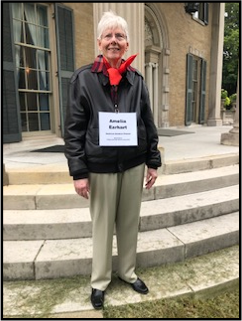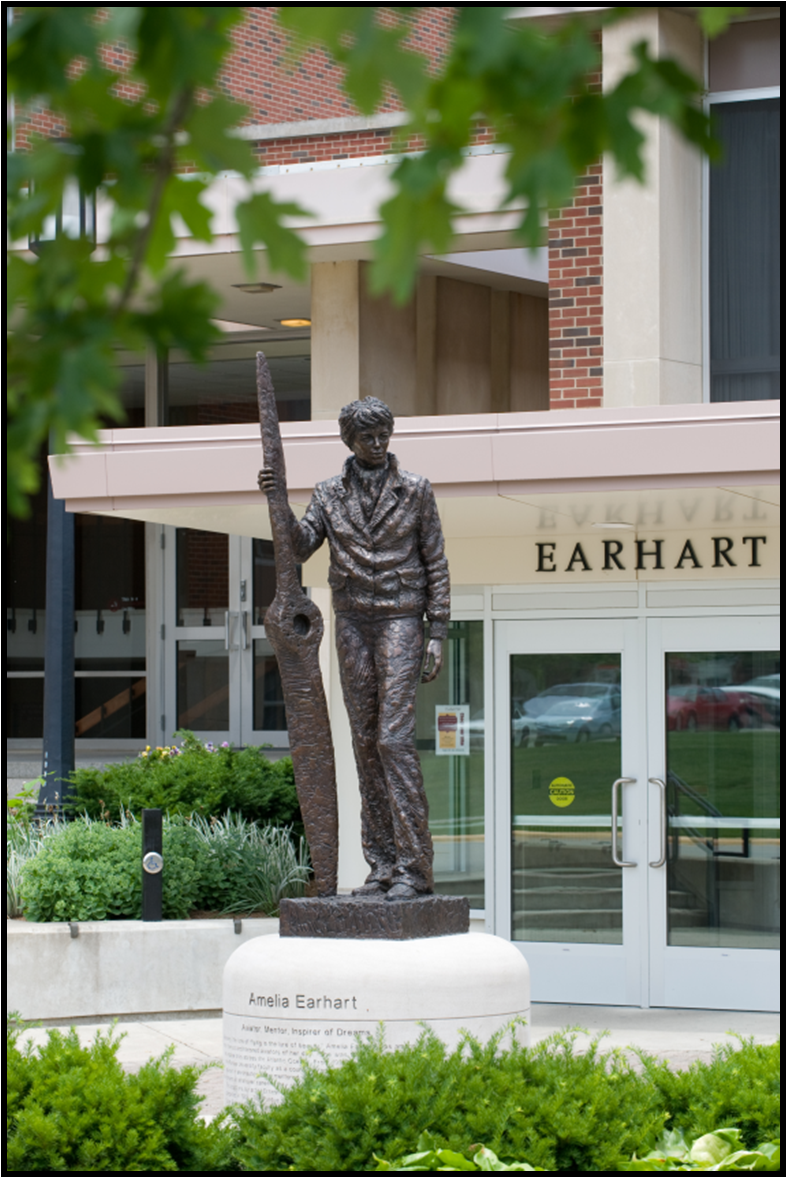Amelia Mary Earhart (1897-1937)
 To help celebrate Purdue University’s 150th anniversary in 2019, the Purdue University Retirees Association (PURA) recruited some of its members to portray historic characters from Purdue’s past.
To help celebrate Purdue University’s 150th anniversary in 2019, the Purdue University Retirees Association (PURA) recruited some of its members to portray historic characters from Purdue’s past.
The reenactors researched their characters, developed costumes and personas, then appeared at a number of public events sharing the stories of these important Purdue figures with the public.
Mary Alice Nebold, pictured here, portrayed Amelia Earhart.
*******
Who would have thought that Amelia Earhart (AE), born July 24, 1897 in Atchison, Kansas, would have made the impact she has on Purdue University, the community, and the world? Considered a “tomboy” as a child, Amelia grew up to be a fearless, independent, determined, adventurous, and courageous young woman whose heart was in flying.
Amelia was introduced to airplanes as a ten year old, but it wasn’t until she took her first plane ride (10 minutes in length) in 1920 that she became hooked on flying. Her flight lessons and her first plane, a Kinner Airster she nicknamed “The Canary,” were paid for with financial support from her family and her earnings from working as a truck driver, a stenographer, and a photographer.
During WWI Amelia served as a nurse’s aide caring for the injured at the Spadina Military Hospital in Toronto. Later, when living in Boston, she was employed as a social worker at Denison House working with immigrant families and children to provide the funds needed to continue flying. In 1923 at the age of 25, she was the 16th woman to obtain a pilot’s license.
In 1928, Amy Guest backed out of the opportunity to be the first woman to fly as a passenger across the Atlantic on the Friendship (the Fokker plane first owned by Commander Byrd). However, Amelia accepted the invitation and kept the flight log for Wilmer Stultz and Louis Gordon on their flight from Newfoundland to Wales. After coming home to a gala parade in New York City, Amelia wrote her second book “20 Hours 40 Minutes” (the flight time required to cross the Atlantic). That flight earned her the name “Lady Lindy.”
A couple of months later, Amelia flew solo across the continental United States and four years later, in 1932, she flew solo across the Atlantic, landing in a farmer’s pasture in Ireland. Amelia made three more “longer” solo flights in 1935 - across the Pacific from Honolulu to California, Los Angeles to Mexico City, and Mexico City to Newark, New Jersey. The latter three flights were firsts for all pilots.
While focusing on flying, AE also engaged in many other endeavors. She wrote poetry, served as aviation editor for Hearst’s Cosmopolitan, and designed flight suits for the Ninety-Nines (the 99 women pilots who organized in 1929 to provide moral support and advance the causes of women in aviation), as well as “clothes for the active woman.” The latter, under her label “Amelia Earhart,” were featured on the front of Vogue and sold at one upscale store in each of thirty U.S. cities (ex.: Macy’s in New York City; Marshall Fields in Chicago). At the same time, Amelia maintained a heavy schedule of speaking engagements. Many of her speeches were about aviation, but others focused on advocacy for women’s rights, careers for women, and partnership in marriage.
In 1934, Purdue President Edward C. Elliott heard Amelia speak at the 4th annual Women’s Conference on Current Problems in New York City. He was speaking as well. In her commentary, Earhart challenged women to be anything they wanted to be and even pursue careers/jobs traditionally held by men. President Elliott was so impressed with her enthusiasm and message he invited her to Purdue to speak to the students. After that initial speech, he offered her a position to come to Purdue to serve as a visiting professor and consultant in the Department of Aeronautical Engineering, as well as a career counselor in the Office of the Dean of Women.

Purdue Marketing & Media
She began her time on campus with lunch with administrators in the School of Home Economics (the school in which most Purdue women were enrolled). Dean Mary L. Matthews and department heads Amy Bloye, Edith Gamble, Amy Howe, Margaret Beeman, and Gertrude Sunderlin were Amelia’s first hostesses. When on campus, Earhart resided in Duhme Hall.
Amelia wore slacks on campus, something women students were not allowed to do. When students asked the Dean of Women, Dorothy Stratton, why she could wear slacks and they could not, Dean Stratton is said to have responded that they could after they soloed over the Atlantic.
When AE was considering flying around the waist (equator) of the planet Earth, Purdue backed her goal by funding the “flying laboratory,” the Lockheed Electra. Amelia and her navigator, Fred Noonan, had completed 22,000 miles of the 29,000 mile journey before becoming lost on July 2, 1937.
Even though she only spent a few short weeks on campus in 1935, 1936, and 1937, eighty-two years after being lost, Amelia Earhart continues to make an impact and inspire men, women, and children at Purdue, in the community, and around the world. AE gained fame because of her aviation records, but she wanted her legacy to reflect her work in the promotion of women’s rights.
Amelia’s grandparents’ home overlooking the Missouri River in Atchison, Kansas is now the Amelia Earhart Birthplace and Museum. Dedicated in 1997, it is owned and maintained by the Ninety-Nines, the women pilots’ organization that Amelia helped to organize and for which she served as first president.
Mary Alice Nebold commented: “What fun it is for me to portray Amelia Earhart for PURA in this year of 150 giant leaps! Attendees at events (faculty members, fourth graders at Delphi Elementary, grandparents, and their grandchildren) added to my enjoyment. Examples of questions asked during my presentations include:
- How did Amelia stay awake on long solo flights?
- How did Amelia prepare for when she needed a restroom during a flight?
- What was her favorite beverage when on campus?
- Why was she lost?
- How much did the fuel weigh when the tanks were filled for the flight from New Guinea to Howland Island?”
Mary Alice suggests that if you want to learn more about Amelia Earhart, check out the following references:
“Ever True” by John Norberg
The Exponent, November 2018
The Lafayette Journal & Courier, November 1935 and 2016
“20 Hours 40 Minutes” by Amelia Earhart, 1929
“Soaring Wings” by George Palmer Putnam, 1939
The Amelia Earhart collection in the Purdue University Archives, http://collections.lib.purdue.edu/aearhart
“Miscellany,” a publication of the Purdue Alumni Association, 2019
Biography – The Official Licensing Website of Amelia Earhart
Amelia Earhart and Purdue/ Moment in Indiana History
Facts About Amelia Earhart/The Children’s Museum of Indianapolis
Wikipedia
Return to PURA Historical Character Project Page
